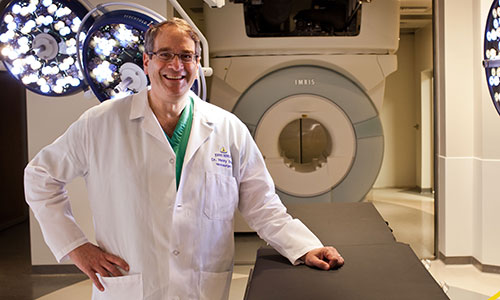Brain Tumor Treatment
There is more hope than ever before for people with brain tumors. Research has helped create advanced treatments such as tumor-treating fields and other innovations.
The treatment for a brain tumor will depend on many things, including the type, size and location of the tumor, as well as your symptoms, general health and treatment preferences. The main treatment options for a brain tumor include:
- Surgery
- Radiation therapy
- Chemotherapy
- Targeted drug therapy
- Tumor treating fields
- Clinical trials
- Follow-up care and rehabilitation
If you’ve been diagnosed with a specific type of brain tumor, see what treatments may be available to you:
Brain Tumor Surgery
Surgery is the most common treatment for brain tumors, and in a lot of cases it’s the only treatment needed. There are numerous surgical approaches to remove brain tumors depending on their size and location.
Learn more about brain tumor surgery or explore the various procedures:
- Craniotomy: the temporary removal of a piece of skull to allow surgeons access to the brain
- Awake brain tumor surgery: Patients are kept sedated and comfortable — but awake — during surgery so doctors can ensure normal brain function is unaffected.
- Neuroendoscopy: Surgeons enter the brain through other parts of the body, like the nose, to better reach certain regions and minimize scarring.
- MRI-guided laser ablation and laser interstitial thermal therapy (LITT): Radiologists and neurosurgeons use computer technology and intraoperative imaging to locate a tumor and precisely destroy the cancerous cells with lasers or heat.
- Biopsy: Doctors take a small sample of brain tumor tissue to examine under a microscope.
- Neuroplastic surgery: This neurosurgical approach preserves and restores skull appearance and anatomy after invasive procedures.
The Johns Hopkins Brain Tumor Center

The Johns Hopkins Comprehensive Brain Tumor Center is one of the largest brain tumor treatment and research centers in the world. We tailor each patient's treatment using an array of advanced approaches, including emerging treatments such as tumor-treating fields and MRI-guided laser ablation.
Radiation Therapy for Brain Cancer and Brain Tumors
Radiation therapy uses X-rays and other forms of light energy to destroy cancer cells in malignant tumors or to slow the growth of a benign brain tumor. Learn more about radiation therapy, or explore the types of radiation therapy used to treat brain tumors:
- External beam radiation therapy: The most common type of radiation therapy for brain tumors, it can be directed to the tumor and nearby brain tissue or to the whole brain. Whole-brain radiation is sometimes used to treat metastatic brain tumors, especially when there are multiple metastatic tumors throughout the brain, including tumors that are too small to be seen on a scan.
- Stereotactic radiosurgery: This form of radiation therapy uses smaller, more targeted beams of X-rays to spare healthy surrounding tissue. It is often used on areas of the brain that are difficult to reach.
- Proton therapy: This uses a particle, the proton, to deliver radiation. Proton therapy may be a good choice for certain types of tumors. Compared with other methods, it delivers less radiation to surrounding healthy tissue.
Chemotherapy for Brain Cancer
Chemotherapy drugs are medicines that kill cancer cells. Chemotherapy is rarely used as a stand-alone treatment for brain tumors; it is often used in combination with surgery and/or radiation. Researchers have pioneered different ways to get chemotherapy drugs into the brain, including surgically implanted wafers such as Gliadel. To mop up any lingering cancer cells, surgeons use these wafers to line the area left behind after a tumor is removed.
Learn more about chemotherapy for brain tumors.
Targeted Drug Therapy for Brain Tumors
Targeted drug therapies are medications that selectively attack specific cell traits to halt a tumor’s spread. Unlike chemotherapy, targeted therapies spare healthy tissue, so they generally have fewer, milder side effects. These drugs are most often used to treat metastatic brain tumors and are frequently paired with other therapies like surgery or radiation.
Tumor Treating Fields
Tumor treating fields use painless electrical pulses to interrupt brain tumor cell division. This slows their growth and spread. The device is portable and resembles a swim cap connected to a small backpack. The device can cause local side effects, such as scalp irritation, and requires frequent head shaving.
Clinical Trials
Clinical trials are an important form of clinical research. They are designed to test new therapies or diagnostic techniques in patients. In general, clinical trials address whether a new treatment or technique is safe and more effective than existing therapies. Brain tumor clinical trials are frequently focused on finding new ways to manage malignant brain tumors.
Involvement in clinical trials generally requires some commitment and comes with certain risks. Clinical trials might be an option for patients whose tumor came back and/or if it’s a tumor known to be aggressive and generally incurable with current therapies.
Some patients wish to start their therapy with experimental agents since there are currently no proven treatments for tumors such as glioblastoma multiforme.
Brain Tumor Clinical Trials
View open trialsFollow-up Care and Rehabilitation After Brain Tumor Treatment
After completion of treatment, your brain tumor care team will help you prepare to leave the hospital, provide follow-up care, and coordinate any necessary rehabilitation services or home care.
Follow-up care after brain tumor treatment may involve seeing a neurosurgeon or neurologist for periodic examinations and brain scans, usually MRIs. The doctor will check for tumor recurrence and possible problems caused by the tumor and/or the treatment, which may include:
- Weakness
- Loss of balance
- Loss of vision
- Loss of memory
- Difficulty speaking
- Difficulty doing complex tasks
- Difficulty making decisions
The brain can sometimes heal itself, but this requires time.
Rehabilitation
To regain some of the affected skills and functions after brain tumor treatment, you may need to stay at a rehabilitation facility, or perform therapy at home or at an outpatient facility. Your doctor will help determine the best type of rehabilitation care.
- If an inpatient stay is recommended, a social worker will help you find a facility close to home and work with your insurance provider to get you set up.
- If home therapy is recommended, the team will arrange for home therapists to visit you. They usually come two to three times a week for 30–60 minutes.
- If outpatient therapy is recommended, you will receive a referral or prescription before leaving the hospital that will detail the type of therapy necessary.
There are different types of rehabilitation specialists who can help you:
- Physical therapists will assess your ability to walk safely and climb stairs before being released from the hospital. They may also help improve strength and balance.
- Occupational therapists will assess your ability to perform activities of daily living such as getting dressed, using the bathroom and getting in and out of the shower. Occupational therapists also test vision and thinking skills to determine whether you can return to work, driving or other challenging tasks.
- Speech-language pathologists evaluate problems with speech, language or thinking. They may also evaluate for swallowing disorders.
Support services, such as counseling, patient education and support groups are available and can typically be accessed through your treatment center even after your treatment has ended.
Living Better With Brain Cancer

Researchers and clinicians at Johns Hopkins are increasingly focused on ensuring that patients with brain tumors can live as comfortably as possible and enjoy the activities they care about most. Meet Tori, whose surgeons developed a treatment plan to preserve her eyesight and allow her to continue doing the things most important to her.





